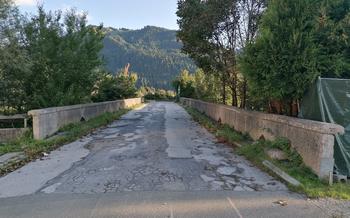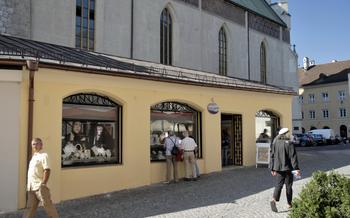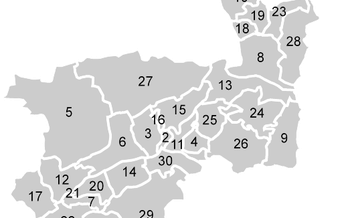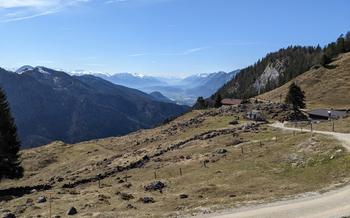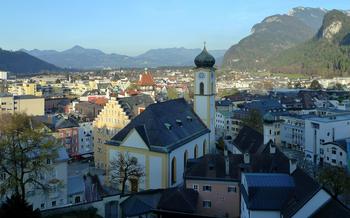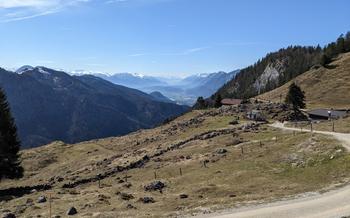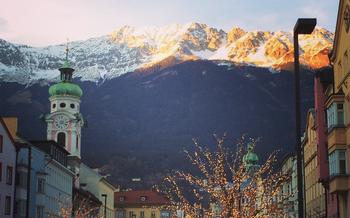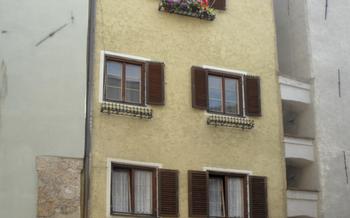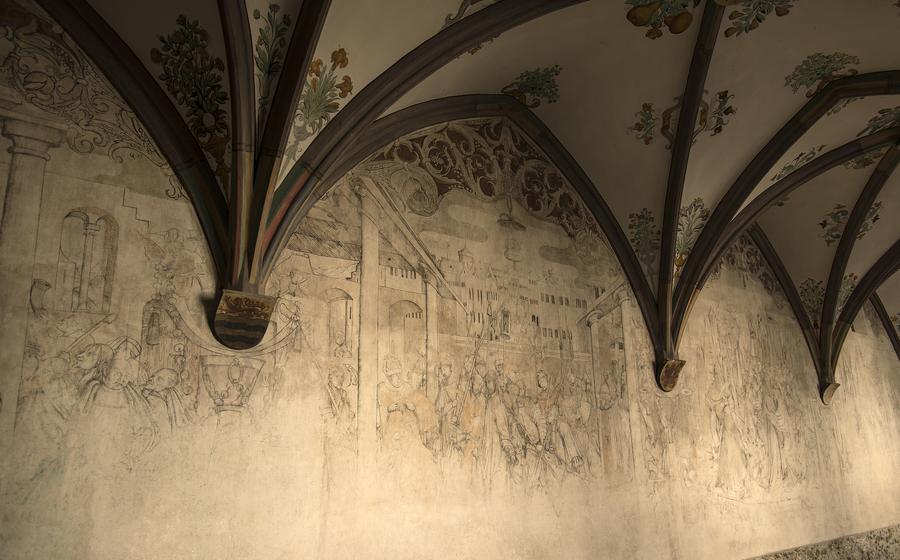
Kufstein Fortress
- Kufstein Fortress: A Majestic Symbol of Austria's History
- Exploring the Fortress Grounds: A Journey Through Time
- Unveiling the Emperor's Room: A Glimpse into Royal Life
- The Hero's Hall: Honoring Tyrolean Heroes
- The Fortress Museum: A Treasure Trove of History
- The 16th-Century Chapel: A Place of Worship and Reflection
- The Bell Tower: A Symbol of Time and Tradition
- The Armory: A Showcase of Medieval Weaponry
- The Casemates: A Hidden Underground World
- The Fortress Restaurant: A Culinary Journey with a View
- Guided Tours: Unveiling the Fortress's Secrets
- Events and Festivals: A Vibrant Cultural Scene
- The Fortress Shop: A Treasure Trove of Souvenirs
- Accessibility and Facilities: Welcoming Visitors of All Ages
- Insider Tip: Exploring the Surrounding Area
Kufstein Fortress: A Majestic Symbol of Austria's History
Standing proudly on a rocky outcrop overlooking the Tyrolean Alps, Kufstein Fortress is a majestic symbol of Austria's rich history. It has been a strategic stronghold for centuries, with its formidable walls and towers guarding the Inn Valley, a crucial trade route between north and south. Over the years, the fortress has undergone several renovations and expansions, each reflecting the changing political and military landscapes. Today, it stands as a testament to the enduring strength and resilience of the Tyrolean people, inviting visitors to delve into its fascinating past and admire its architectural grandeur.
Historical significance: - Originally built in the 13th century to protect the trade route, it has withstood numerous sieges and invasions throughout history. - Served as a prison for political dissidents during the Tyrolean Rebellion of 1809, a pivotal event in the fight for Tyrolean autonomy. - Played a crucial role in the defense of Tyrol during both World Wars, demonstrating its strategic importance.
Architectural features: - A masterpiece of medieval military architecture, the fortress features thick stone walls, imposing towers, and intricate fortifications. - The massive gatehouse, adorned with the Tyrolean eagle, is a symbol of the region's fierce independence and pride. - Within the fortress walls, visitors can explore courtyards, barracks, and secret passageways, each revealing a glimpse into the fortress's rich history.
Stunning views: - Perched high on a hill, the fortress offers breathtaking panoramic views of the surrounding Tyrolean landscape. - The Inn Valley, with its lush meadows and winding river, stretches out before the fortress, creating a picturesque backdrop. - The majestic peaks of the Alps, capped with snow, form a dramatic horizon, providing a stunning vista for visitors to enjoy.
Unique experiences: - Visitors can witness the daily firing of the fortress's cannons, a tradition dating back centuries, which echoes through the valley and adds to the fortress's charm. - The fortress also hosts regular events and festivals throughout the year, such as medieval markets, concerts, and historical reenactments, offering visitors a chance to immerse themselves in the fortress's vibrant atmosphere.
Exploring the Fortress Grounds: A Journey Through Time
Venturing into the grounds of Kufstein Fortress is like stepping back in time. The fortified walls that once protected the fortress from invaders still stand tall, their imposing presence a testament to the fortress's rich history. Towers of various shapes and sizes dot the landscape, each with its own unique story to tell.
At the heart of the fortress lies the inner courtyard, a spacious area that served as the fortress's main gathering place. Here, soldiers once mustered for roll call, prisoners were held, and important ceremonies took place. Today, the inner courtyard is a popular spot for visitors to relax and soak up the fortress's atmosphere.
Hidden passageways and secret staircases lead to unexpected corners of the fortress, revealing hidden chambers and forgotten treasures. Visitors can explore these hidden passageways and discover the fortress's many secrets, feeling like explorers on a thrilling adventure.
The enchanting gardens of the fortress offer a tranquil oasis amidst the historic fortifications. Flowers of all colors bloom in abundance, filling the air with their sweet fragrance. Visitors can stroll through the gardens, admiring the beauty of nature and enjoying the peace and serenity.
Unveiling the Emperor's Room: A Glimpse into Royal Life
In the heart of Kufstein Fortress lies a hidden gem that transports visitors back to a time of opulence and grandeur: the Emperor's Room. This lavishly decorated chamber served as a temporary residence for Emperor Maximilian I, who frequently visited the fortress during his reign in the 15th and 16th centuries.
Step inside the Emperor's Room, and you'll be greeted by an atmosphere of luxury and sophistication. The walls are adorned with intricate tapestries, while the ceiling features stunning frescoes depicting scenes from Tyrolean history. The room is furnished with elegant period pieces, including a stately four-poster bed, a carved wooden writing desk, and a collection of antique chairs.
One of the most fascinating aspects of the Emperor's Room is the personal belongings that have been carefully preserved. Visitors can admire Maximilian I's hunting gear, his collection of coins, and even his personal seal. These artifacts offer a glimpse into the daily life of a powerful ruler and provide a deeper understanding of his character and interests.
As you explore the Emperor's Room, imagine yourself as a guest of the emperor, enjoying the comforts of this magnificent chamber. Listen to the stories of royal visitors who once graced these halls, and let your imagination transport you back to a time when kings and queens ruled the land.
The Hero's Hall: Honoring Tyrolean Heroes
The Hero's Hall, located within the Kufstein Fortress, serves as a poignant tribute to the brave and selfless individuals who have played a pivotal role in shaping Tyrol's rich history. As visitors step into this hallowed space, they are greeted by a gallery of portraits that immortalize the faces of these Tyrolean heroes, each with a unique story of courage and sacrifice to tell.
The hall's serene atmosphere invites contemplation and reflection as visitors learn about the extraordinary lives of these individuals who fought valiantly for their homeland. From freedom fighters who stood up against oppression to ordinary citizens who displayed extraordinary acts of heroism, the Hero's Hall celebrates the indomitable spirit of the Tyrolean people.
Among the many heroes honored in the hall is Andreas Hofer, a charismatic leader who played a crucial role in the Tyrolean Rebellion of 1809 against Bavarian rule. Hofer's unwavering determination and strategic leadership inspired his fellow countrymen to rise up in arms and fight for their freedom. His legacy as a symbol of Tyrolean resistance continues to resonate to this day.
The Hero's Hall is not merely a place of commemoration but also a reminder of the sacrifices made by countless Tyroleans throughout history. It serves as a testament to the power of human resilience and the enduring spirit of a people who have repeatedly overcome adversity.
The Fortress Museum: A Treasure Trove of History
The Fortress Museum, housed within the walls of Kufstein Fortress, is a treasure trove of historical artifacts and exhibits that provide visitors with a fascinating glimpse into the fortress's rich past and the lives of its former inhabitants. Through interactive displays, multimedia presentations, and a diverse collection of artifacts, the museum brings the history of the fortress to life.
Exhibits in the museum cover a wide range of topics, from the fortress's early origins and its role in defending the Tyrolean border to its use as a prison and a military barracks. Visitors can learn about the various sieges and battles that the fortress has endured, as well as the stories of the people who lived and worked within its walls.
One of the highlights of the museum is the collection of weapons and armor from different eras, which provides visitors with an insight into the military history of the fortress. The museum also houses a collection of personal belongings and documents that belonged to past residents of the fortress, offering a glimpse into their daily lives and the challenges they faced.
The Fortress Museum is a must-visit for anyone interested in history and culture. Its exhibits offer a comprehensive overview of the fortress's history and provide visitors with a deeper understanding of the role it played in shaping the region's past.
The 16th-Century Chapel: A Place of Worship and Reflection
Nestled within the walls of Kufstein Fortress lies a hidden gem of tranquility and devotion – the 16th-century chapel. This sacred space exudes an atmosphere of peace and reflection, inviting visitors to immerse themselves in its rich history and spiritual significance.
The chapel's architectural style is a testament to the era in which it was built. Its Gothic features, with pointed arches and intricate stonework, create a sense of awe and reverence. The interior is adorned with beautiful artwork and stained glass windows, depicting scenes from the Bible and the lives of saints. These stunning works of art add to the chapel's serene and contemplative ambiance.
Originally used by the fortress's inhabitants for religious services, the chapel played a crucial role in the spiritual lives of those who lived and worked within these walls. Today, it continues to serve as a place of worship and reflection for visitors from all walks of life. Its peaceful ambiance and historical significance make it a popular destination for those seeking solace and inspiration.
The Bell Tower: A Symbol of Time and Tradition
Amidst the many architectural wonders of Kufstein Fortress, the bell tower stands tall as a symbol of time and tradition. Its history is deeply intertwined with the fortress's past, as it once served as a watchtower, keeping a vigilant eye over the surrounding lands. Today, visitors can ascend the tower's winding staircase to be rewarded with breathtaking panoramic views of the fortress, the town of Kufstein, and the stunning Tyrolean landscape.
One of the most captivating legends associated with the bell tower is the tale of the "Giant Haystack." According to local folklore, a massive haystack once stood near the fortress, so large that it could be seen from miles away. One day, a mischievous gnome decided to play a trick on the local farmers by setting fire to the haystack. The flames spread rapidly, casting an eerie glow over the night sky. The farmers, thinking that the fortress was under attack, rushed to defend it, only to discover the gnome's mischievous deed.
Bells have always played a significant role in Tyrolean culture, serving as a means of communication and a symbol of community. The bells of Kufstein Fortress have rung out for centuries, marking the hours, calling people to prayer, and signaling important events. Their melodious chimes echo through the valley, creating a peaceful and enchanting atmosphere that transports visitors back in time.
The Armory: A Showcase of Medieval Weaponry
A step into the armory of Kufstein Fortress is a journey back in time to the era of knights, battles, and heroic conquests. This impressive collection houses a vast array of medieval weaponry, each piece telling a story of valor and combat. From gleaming swords and intricate suits of armor to crossbows, halberds, and maces, the armory offers a glimpse into the tools of warfare that shaped the course of history.
The exhibits are arranged in a captivating manner, allowing visitors to trace the evolution of weapons and armor through the ages. Interactive displays and detailed descriptions provide insights into the craftsmanship, functionality, and historical significance of each item. Visitors can marvel at the intricate details of etched blades, the weight and balance of chain mail, and the ingenuity of defensive armor designed to withstand the fiercest attacks.
In addition to the static displays, the armory also hosts demonstrations of medieval combat techniques. Skilled reenactors don authentic armor and engage in mock battles, showcasing the martial prowess and skills of the era. These demonstrations bring the history of the fortress to life and offer a glimpse into the realities of medieval warfare.
The Casemates: A Hidden Underground World
Deep beneath the imposing walls of Kufstein Fortress lies a hidden realm of mystery and intrigue - the casemates. These subterranean chambers, carved into the bedrock centuries ago, served as a vital defense mechanism during times of war, providing shelter for soldiers and supplies. Today, these atmospheric spaces have been transformed into exhibition areas, offering visitors a glimpse into the fortress's rich history and the lives of its past inhabitants.
The casemates are a labyrinth of narrow corridors and vaulted rooms, their walls adorned with centuries-old graffiti and inscriptions left by soldiers who once sought refuge within these underground chambers. Interactive displays and multimedia presentations bring the history of the fortress to life, shedding light on the strategic importance of the casemates and the role they played in defending the region against invading forces.
Visitors can explore the casemates on a guided tour, gaining insights into the ingenious construction techniques employed by medieval builders and the harsh conditions endured by soldiers who manned these underground fortifications. The unique atmosphere of the casemates, with its dimly lit corridors and echoes of history, creates a sense of awe and wonder, transporting visitors back to a time when the fortress stood as a formidable symbol of power and resilience.
The Fortress Restaurant: A Culinary Journey with a View
Nestled within the historic walls of Kufstein Fortress, the fortress restaurant offers a unique culinary experience that blends traditional Tyrolean flavors with stunning panoramic views. Immerse yourself in the charm of this centuries-old setting as you savor delectable regional specialties prepared with fresh local ingredients.
Indulge in hearty Tyrolean dishes such as Käsespätzle (cheese spaetzle), Tiroler Gröstl (fried potatoes with meat and onions), or Knödel (dumplings) accompanied by a refreshing glass of Tyrolean beer or wine. The restaurant also features a selection of international dishes to cater to diverse tastes.
Enjoy your meal in the elegant dining room, which combines historic ambiance with modern comforts, or take your culinary experience to new heights by dining on the panoramic terrace. As you savor the delicious cuisine, let your gaze wander across the breathtaking views of the Tyrolean Alps and the Inn Valley, creating an unforgettable dining experience.
Guided Tours: Unveiling the Fortress's Secrets
To delve deeper into the fascinating history and legends of Kufstein Fortress, guided tours are a must. Professional guides, well-versed in the fortress's rich past, lead visitors through its various sections, shedding light on its construction, military significance, and the lives of its former inhabitants. These tours are available in multiple languages and can be tailored to different interests and age groups.
For families with children, special tours are designed to engage young minds with interactive activities and storytelling. These tours bring the fortress's history to life, allowing children to imagine themselves as knights and princesses exploring the castle's hidden corners.
Group tours offer a unique opportunity for team building and camaraderie. Guides can customize the tour to highlight specific aspects of the fortress's history that resonate with the group's interests. Whether it's the fortress's role in defending Tyrol against invaders or the stories of its famous prisoners, there's something for everyone to discover.
Guided tours provide an immersive experience that allows visitors to connect with the spirit of Kufstein Fortress. They offer a deeper understanding of its significance and leave visitors with lasting memories of this iconic landmark.
Events and Festivals: A Vibrant Cultural Scene
The Kufstein Fortress is not just a historical landmark but also a vibrant cultural hub that hosts a variety of events and festivals throughout the year. These events bring the fortress to life and offer visitors a chance to experience its rich history and traditions in a unique way.
One of the highlights is the annual "Kufstein Fortress Concerts", a prestigious music festival that takes place in the fortress's inner courtyard. Renowned orchestras and soloists from around the world perform classical concerts against the backdrop of the stunning fortress walls, creating a magical atmosphere.
The fortress also hosts "Medieval Festivals", which transport visitors back in time to the Middle Ages. During these festivals, the fortress grounds are transformed with historical reenactments, craft demonstrations, and traditional music and dance performances. Visitors can witness knights in shining armor, archers showcasing their skills, and artisans creating beautiful works of art using medieval techniques.
During the festive season, the fortress hosts a "Christmas Market", where visitors can browse stalls selling traditional Tyrolean crafts, decorations, and culinary delights. The market is set against the backdrop of the illuminated fortress, creating a truly magical and heartwarming experience.
These are just a few examples of the many events and festivals held at the Kufstein Fortress. With its unique setting and rich history, the fortress provides an unforgettable backdrop for a variety of cultural experiences that will appeal to visitors of all ages.
The Fortress Shop: A Treasure Trove of Souvenirs
As you exit the fortress, don't miss the opportunity to visit the charming fortress shop, where you can find a treasure trove of unique souvenirs and gifts to commemorate your visit. Browse through a carefully curated selection of local crafts and products, including handmade Tyrolean pottery, intricately carved wooden souvenirs, and traditional textiles.
For those seeking a deeper understanding of the fortress's history and significance, there is a selection of books and publications available, offering insights into its past and the stories of its inhabitants. By purchasing these items, you not only take home a tangible reminder of your visit but also contribute to the ongoing preservation and maintenance of this remarkable fortress.
Accessibility and Facilities: Welcoming Visitors of All Ages
Kufstein Fortress is committed to providing a welcoming and accessible experience for all visitors. The fortress grounds are wheelchair accessible, with ramps and elevators installed to ensure easy navigation. For families with young children, there are stroller-friendly paths and changing facilities available. The fortress also offers guided tours specifically designed for families, with engaging activities and storytelling to keep children entertained and interested.
In terms of parking, there are designated parking areas for visitors, including spaces reserved for disabled individuals. Public transportation is also a convenient option, with bus stops located nearby. A visitor information center at the entrance of the fortress provides maps, brochures, and assistance to ensure a smooth and enjoyable visit for all guests.
Insider Tip: Exploring the Surrounding Area
A visit to Kufstein Fortress can be complemented by exploring the surrounding area, which offers a wealth of hidden gems and attractions. Nature enthusiasts can embark on scenic hikes along the nearby trails, immersing themselves in the breathtaking landscapes of the Tyrolean Alps. The region is also a paradise for cyclists, with numerous well-marked bike paths winding through picturesque villages and stunning natural scenery.
For those seeking cultural experiences, the charming towns and villages in the vicinity of the fortress invite exploration. Take a leisurely stroll through the cobblestone streets of Schwaz, admiring the medieval architecture and visiting the local museums and galleries. Rattenberg, known as the "glass city," is home to a thriving glass-blowing industry and offers visitors the chance to witness skilled artisans at work.
Venturing further afield, Innsbruck, the capital of Tyrol, is a must-see destination, boasting a rich history, stunning Alpine vistas, and a vibrant cultural scene. With its imperial palaces, museums, and lively squares, Innsbruck offers a captivating blend of history, culture, and natural beauty.
